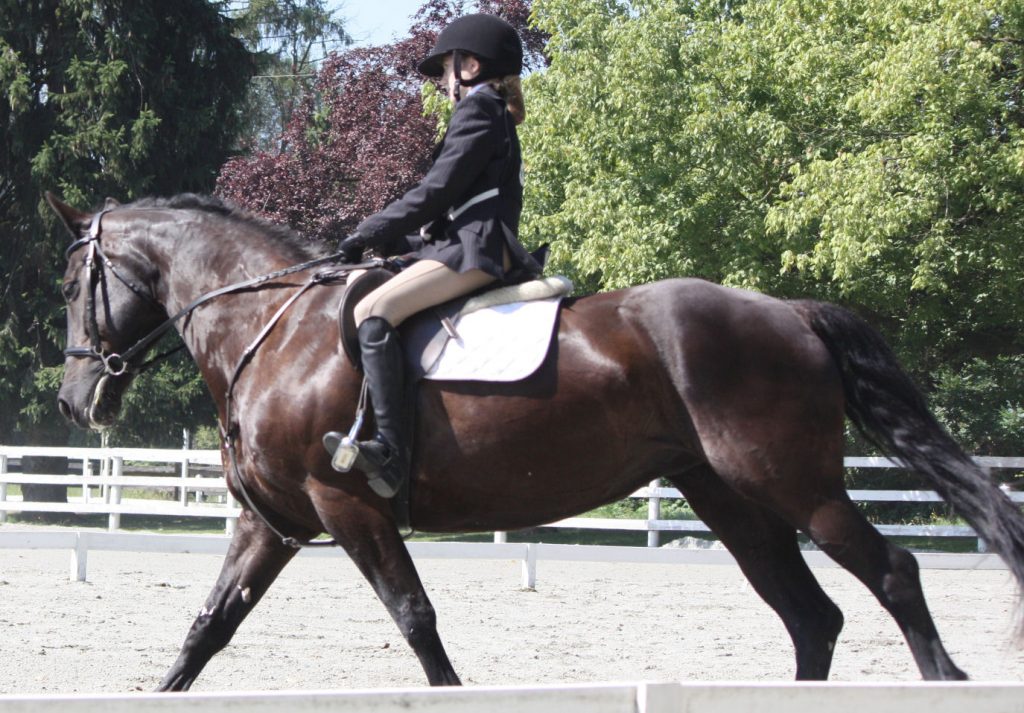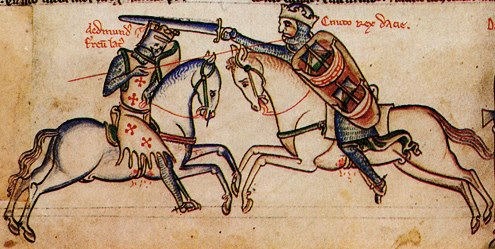Riding Level 2: The Canter
Level 1 Riding is all done at the walk and trot. However, the most useful gait for advanced Mounted Combat is the canter. A horse in a balanced canter is smooth to ride, and can move swiftly in and out of melee, turning with precision to help his rider deliver accurate blows and avoid counter-strikes. Along with the gallop it is also the gait used in cavalry charges and jousting.
The At level 2 we aren't looking for the high level collected canter of the dressage horse, the adjustability of the jumper, or a smooth hunting hand-gallop. All we want to see is:
11. Canter both directions (without emphasis on position or lead)
Asking for canter
The basic cues for canter are as follows:
- begin from a working trot
- sit the trot and half-halt, warning your horse a transition is coming
- slide the outside leg back slightly (about 3 or 4 inches)
Take a look at this video to watch the canter transition.
The horse in this video picks up the canter quite promptly. Some horses may need more encouragement to pick up the canter this can include:
- firmer pressure or a nudge at the girth from the inside leg
- a cluck or kissing noise, or the verbal cue "can-TER"
- a tap of the whip behind the leg
If the horse still doesn't make the transition to canter, here is a check list of items that may be hindering him
- he is trotting too fast. If a horse gets into a very quick or strung-out trot it's harder for him to get his hind legs under him and initiate the canter. Half-halt to steady him and bring him into balance before re-asking.
- the rider is loose in the saddle. If the rider is bouncing around she won't be able to support the horse with her seat and legs and her cues may be inconsistent. Sit deeply, and keep the legs firm and quiet.
- the rider is holding back with the reins. Out of nervousness some beginning riders take up too much contact and hold the horse back. Sometimes it helps to put the reins in one hand and grab the pommel for security when first learning to canter. This helps stop the rider from balancing on the horse's mouth and gives him freedom to move his neck in the canter.
Maintaining the canter
One of the main dificulties for riders learning to canter is keeping the gait. Often a horse will make a nice canter depart, give a few strides, and then shift back down to trot. The reasons are often similar to those listed above:
- the rider is loose in the saddle. Although the canter is a smoother gait than the trot, it is a 'larger'. If the rider is not secure in her seat the canter will make her slew back and forth which is uncomfortable for the horse, and will cause him to come back to trot. Take more weight in the stirrup irons. If it is too hard to sit deeply, the rider can come into a light seat or two point position to avoid interfering with the horse's back.
- the rider is too light in the saddle. Notwithstanding the advice above, some horses need a firm driving seat to maintain a canter. There is no help for this but to improve your seat with plenty of stirrupless work!
- the rider is bumping the horse's mouth. Sometimes the spring into canter causes the rider to involuntarily pull back on the reins. This will cause the horse to drop back to trot. Similarly, if the rider's hands are not following the movement of the head, the horse will receive a jolt in the mouth at every stride. As above, riding with one hand on the reins will help, as will learning to canter on the longe line, where the rider needs no hands on the reins at all.
- the horse needs more support through the corners. Just as you have to pedal harder on a bicycle, or put more gas into a turn, a horse often needs extra encouragement to maintain the faster gaits through turns. Anticipate this, and be prepared to add a little extra leg through the turns. Giving a balancing half-halt before the turn will also help the horse get 'under' himself and maintain the gait.
Cantering can be a bit nerve-wracking at first, but once you've mastered it you'll come to love the smooth rocking-horse motion. And once you can canter, the doors open to jumping and galloping, which is pure wind-in-your-teeth exhillaration!
Next: identifying canter leads


